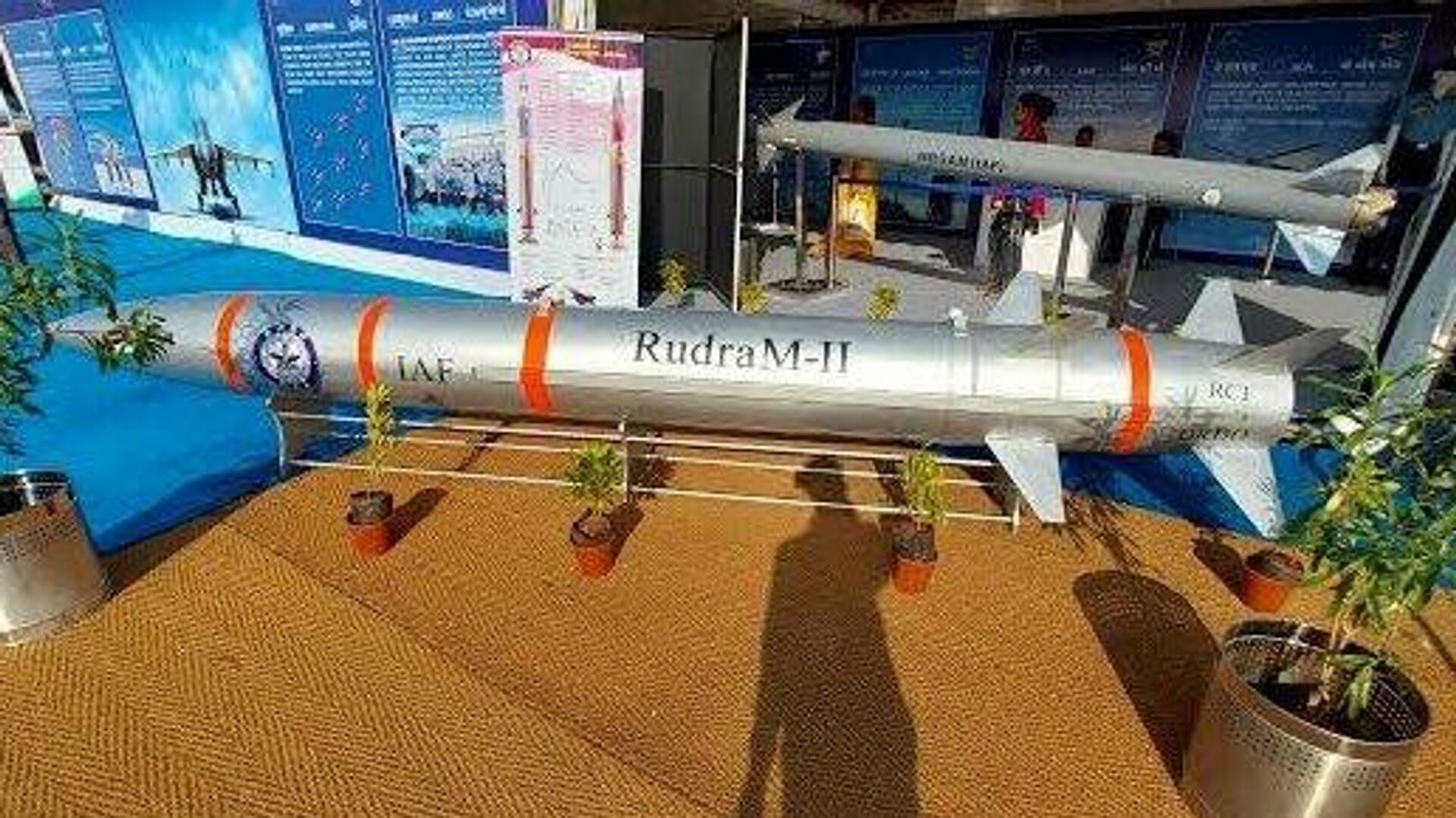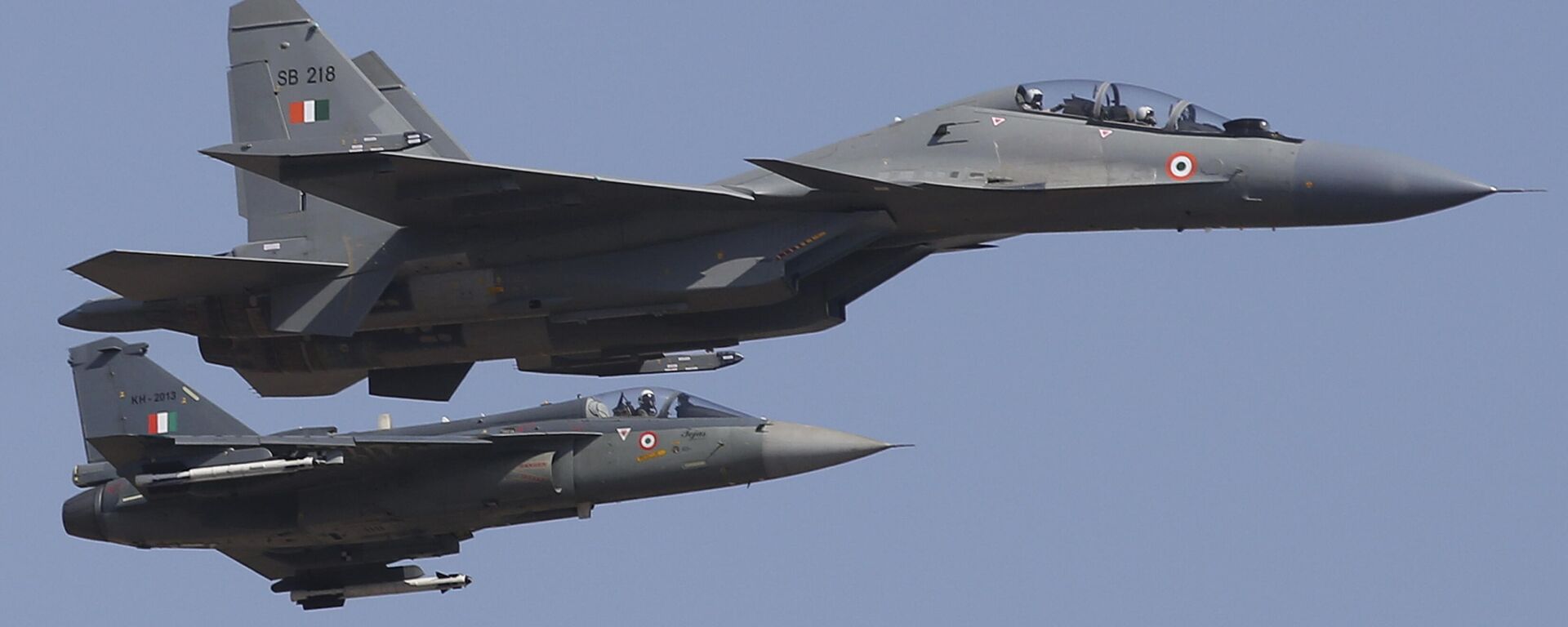https://sputniknews.in/20240610/how-rudram-ii-missile-will-change-the-face-of-iafs-fighter-jet-fleet-7583245.html
How RudraM-II Missile Will Change the Face of IAF's Fighter Jet Fleet
How RudraM-II Missile Will Change the Face of IAF's Fighter Jet Fleet
Sputnik India
RudraM-II is set to transform the face of the Indian Air Force's (IAF) combat capabilities as the missile is set to be inducted in all varieties of fighter jets of the South Asian nation's sky guarding force.
2024-06-10T20:58+0530
2024-06-10T20:58+0530
2024-06-11T12:13+0530
explainers
india
russia
odisha
indian air force (iaf)
sukhoi su-30mki
lca tejas
rudram-ii missile
missiles
anti-radiation missiles
https://cdn1.img.sputniknews.in/img/07e8/06/0a/7587305_15:0:531:290_1920x0_80_0_0_02be9706dafb11eaac5b8c49e66a7d62.jpg
RudraM-II is set to transform the face of the Indian Air Force's (IAF) combat capabilities as the missile is set to be inducted in all varieties of fighter jets of the nation's sky guarding force.According to media reports, the Defence Research and Development Organisation (DRDO) is working on a plan to make the projectile adaptive to all the warplanes of the IAF.The RudraM-II development into a missile that fits all (read fighter jets) will put it on a different pedestal altogether, as currently, the IAF does not have an indigenously developed supersonic ALCM (Air Launched Cruise Missile) that can be launched by all IAF fighters, military analyst and IAF veteran Vijainder K Thakur told Sputnik India on Monday.Though India has the BrahMos-A in its arsenal which is a joint Indo-Russian projectiles. While it is a very effective weapon system, it can only be launched by Su-30MKI fighter jets.Specifications of RudraM-IIMeanwhile, last month, the DRDO announced the successful firing of the RudraM-II – the new version of India's maiden anti-radiation missile RudraM – from a Su-30MKI fighter jet.Meanwhile, the overall weight of the Rudram-II is 800 kilograms. It has a warhead capacity of 200 kg. The projectile can fly at a top speed of 6,791 km/h (Mach 5.5) from an elevation of 3 to 15 km, making it one of the most destructive weapons on the planet.While its original version could only be launched through the IAF's Su-30MKI fighter jets, the RudraM-II can also be fired from its fleet of French-origin Mirage-2000 aircraft, bolstering the IAF's combat prowess manifold.As the IAF has a wide variety of aircraft, equipping them with the same set of missiles is difficult.However, at present, the IAF's fighter aircraft fleet uses the indigenous LCA Tejas and French and Russian-origin aircraft. Among the French Mirages combat planes the IAF uses Rafales as well. On the other hand, the Su-30MKIs and MiG-29s form the lynchpin of India's warplanes fleet.
https://sputniknews.in/20240223/indias-indigenous-anti-radiation-missile-rudram-iii-enhances-air-force-capabilities-6655238.html
india
russia
odisha
Sputnik India
feedback.hindi@sputniknews.com
+74956456601
MIA „Rossiya Segodnya“
2024
Pawan Atri
https://cdn1.img.sputniknews.in/img/07e6/0c/13/139630_147:0:831:684_100x100_80_0_0_8fa2b25903e7787fe6a2698552c167df.png
Pawan Atri
https://cdn1.img.sputniknews.in/img/07e6/0c/13/139630_147:0:831:684_100x100_80_0_0_8fa2b25903e7787fe6a2698552c167df.png
News
en_IN
Sputnik India
feedback.hindi@sputniknews.com
+74956456601
MIA „Rossiya Segodnya“
Sputnik India
feedback.hindi@sputniknews.com
+74956456601
MIA „Rossiya Segodnya“
Pawan Atri
https://cdn1.img.sputniknews.in/img/07e6/0c/13/139630_147:0:831:684_100x100_80_0_0_8fa2b25903e7787fe6a2698552c167df.png
drdo rudram 2 missile, what is rudram-2, rudram 2, india's super killer missile, india's first indigenously developed anti-radiation missile, how fast is the rudram-2 missile, what is the latest missile of drdo, what is the cost of rudram missile, kh-31, russia's anti-radiation missile, su-57 armed with supersonic death, supersonic air to surface ballistic missile, which is the best anti-radiation missile in the world, what is the anti radiation weapon of india, what is the range of the rudram-2 missile, how fast is the anti-radiation missile, rudram-ii missile, what is rudram-ii, rudram-ii, drdo rudram-ii,
drdo rudram 2 missile, what is rudram-2, rudram 2, india's super killer missile, india's first indigenously developed anti-radiation missile, how fast is the rudram-2 missile, what is the latest missile of drdo, what is the cost of rudram missile, kh-31, russia's anti-radiation missile, su-57 armed with supersonic death, supersonic air to surface ballistic missile, which is the best anti-radiation missile in the world, what is the anti radiation weapon of india, what is the range of the rudram-2 missile, how fast is the anti-radiation missile, rudram-ii missile, what is rudram-ii, rudram-ii, drdo rudram-ii,
How RudraM-II Missile Will Change the Face of IAF's Fighter Jet Fleet
20:58 10.06.2024 (Updated: 12:13 11.06.2024) Inspired by close strategic partner Russia's Kh-31 series of missiles, the RudraM-II is the latest addition to India's large inventory of projectiles, developed mainly to neutralize enemy radars.
RudraM-II is set to transform the face of the Indian Air Force's (IAF) combat capabilities as the missile is set to be inducted in all varieties of fighter jets of the nation's sky guarding force.
According to media reports, the
Defence Research and Development Organisation (DRDO) is working on a plan to make the projectile adaptive
to all the warplanes of the IAF.
The RudraM-II development into a missile that fits all (read fighter jets) will put it on a different pedestal altogether, as currently, the IAF does not have an indigenously developed supersonic ALCM (Air Launched Cruise Missile) that can be launched by all IAF fighters, military analyst and IAF veteran Vijainder K Thakur told Sputnik India on Monday.
"The RudraM-II is optimized for SEAD (suppression of enemy, air defense) operations. It can be used to destroy ground-based air defense radars or static targets, like aircraft in shelters, underground ammunition storage, and maintenance facilities. The RudraM-II could also be used as an anti-shipping missile," Thakur emphasized.
Though India has the BrahMos-A in its arsenal which is a joint Indo-Russian projectiles. While it is a very effective weapon system, it can only be launched by Su-30MKI fighter jets.
Specifications of RudraM-II
Meanwhile, last month, the DRDO announced the
successful firing of the RudraM-II – the new version of India's maiden anti-radiation missile RudraM – from a
Su-30MKI fighter jet.
"The most outstanding feature of RudraM-II is its high supersonic cruise speed, which makes interception by adversary air defense units difficult. Also, the high impact speed of the missile makes it more destructive than a similarly sized subsonic cruise missile," the military pundit observed.
Meanwhile, the overall weight of the Rudram-II is 800 kilograms. It has a
warhead capacity of 200 kg. The projectile can fly at a top speed of 6,791 km/h (Mach 5.5) from an elevation of 3 to 15 km, making it one of the most destructive weapons on the planet.
While its original version could only be launched through the IAF's Su-30MKI fighter jets, the RudraM-II can also be fired from its fleet of French-origin Mirage-2000 aircraft, bolstering the IAF's combat prowess manifold.
As the IAF has a wide variety of aircraft,
equipping them with the same set of missiles is difficult.
However, at present, the IAF's fighter aircraft fleet uses the indigenous LCA Tejas and French and Russian-origin aircraft. Among the French Mirages combat planes the IAF uses Rafales as well. On the other hand, the Su-30MKIs and MiG-29s form the lynchpin of India's warplanes fleet.



